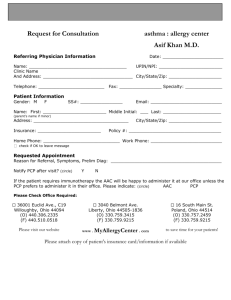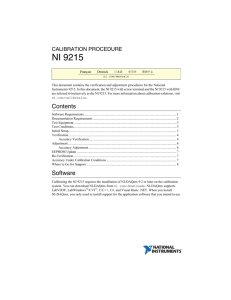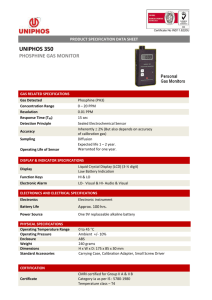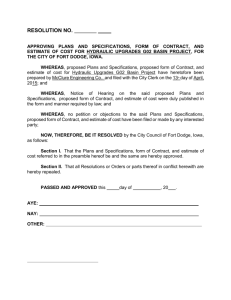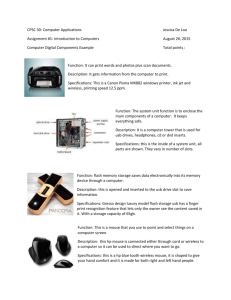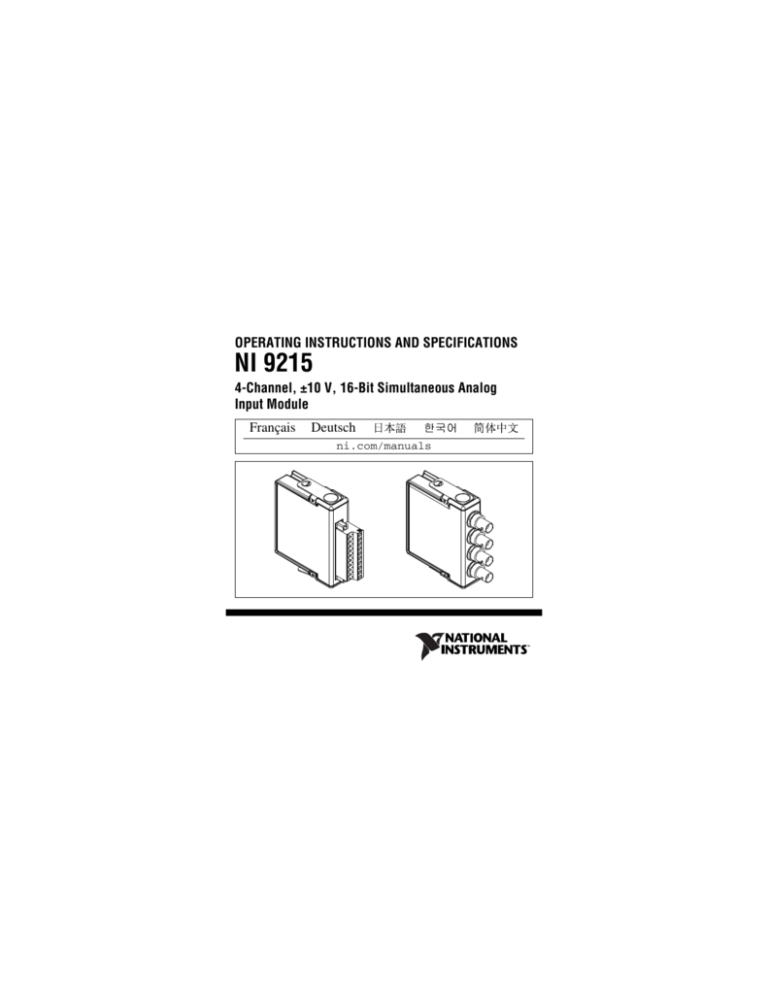
OPERATING INSTRUCTIONS AND SPECIFICATIONS
NI 9215
4-Channel, ±10 V, 16-Bit Simultaneous Analog
Input Module
Français
Deutsch
ni.com/manuals
This document describes how to use the National Instruments 9215
and includes specifications and terminal assignments for the
NI 9215. In this document, the NI 9215 with screw terminal and
NI 9215 with BNC are referred to inclusively as the NI 9215. For
information about installing, configuring, and programming the
system, refer to the system documentation. Visit ni.com/info
and enter the following Info Codes:
•
cseriesdoc—for information about C Series and system
•
compatibility—for information about chassis and carrier
•
rdsoftwareversion—for information about which software
documentation.
compatibility for the modules you are using.
you need for the modules you are using.
Note The safety guidelines and specifications in this
document are specific to the NI 9215. The other
components in the system might not meet the same safety
ratings and specifications. Refer to the documentation for
each component in the system to determine the safety
ratings and specifications for the entire system. Visit
ni.com/info and enter cseriesdoc for information
about C Series documentation.
NI 9215 Operating Instructions and Specifications
2
ni.com
Safety Guidelines
Operate the NI 9215 only as described in these operating
instructions.
Hot Surface This icon denotes that the component may be
hot. Touching this component may result in bodily injury.
Safety Guidelines for Hazardous Voltages
You can connect hazardous voltages only to the NI 9215 with
screw terminal. Do not connect hazardous voltages to the NI 9215
with BNC.
If hazardous voltages are connected to the module, take the
following precautions. A hazardous voltage is a voltage greater
than 42.4 Vpk or 60 VDC to earth ground.
Ensure that hazardous voltage wiring is
performed only by qualified personnel adhering to local
electrical standards.
Caution
Caution Do not mix hazardous voltage circuits and
human-accessible circuits on the same module.
© National Instruments Corp.
3
NI 9215 Operating Instructions and Specifications
Make sure that devices and circuits connected to
the module are properly insulated from human contact.
Caution
When module terminals are hazardous voltage
LIVE (>42.4 Vpk /60 VDC), you must ensure that devices
and circuits connected to the module are properly
insulated from human contact. You must use the NI 9932
connector backshell kit to ensure that the terminals are
not accessible.
Caution
Figure 1 shows the NI 9932 connector backshell.
Note You can use the NI 9932 connector backshell only
with the NI 9215 with screw terminal.
NI 9215 Operating Instructions and Specifications
4
ni.com
Figure 1. NI 9932 Connector Backshell
Safety Guidelines for Hazardous Locations
The NI 9215 is suitable for use in Class I, Division 2, Groups A, B,
C, D, and T4 hazardous locations; Class I, Zone 2, AEx nC IIC T4
and Ex nC IIC T4 hazardous locations; and nonhazardous locations
only. Follow these guidelines if you are installing the NI 9215 in a
potentially explosive environment. Not following these guidelines
may result in serious injury or death.
Caution Do not disconnect I/O-side wires or connectors
unless power has been switched off or the area is known
to be nonhazardous.
© National Instruments Corp.
5
NI 9215 Operating Instructions and Specifications
Do not remove modules unless power has been
switched off or the area is known to be nonhazardous.
Caution
Substitution of components may impair
suitability for Class I, Division 2.
Caution
For Division 2 and Zone 2 applications, install
the system in an enclosure rated to at least IP 54 as
defined by IEC 60529 and EN 60529.
Caution
For Division 2 and Zone 2 applications,
connected signals must be within the following limit:
Caution
Capacitance .......................... 0.2 F max
Special Conditions for Hazardous Locations Use in Europe
This equipment has been evaluated as Ex nC IIC T4 equipment
under DEMKO Certificate No. 03 ATEX 0324020X. Each module
is marked
II 3G and is suitable for use in Zone 2 hazardous
locations, in ambient temperatures of –40 °C Ta 70 °C. If you
are using the NI 9215 in Gas Group IIC hazardous locations, you
must use the device in an NI chassis that has been evaluated as
Ex nC IIC T4, EEx nC IIC T4, Ex nA IIC T4, or Ex nL IIC T4
equipment.
NI 9215 Operating Instructions and Specifications
6
ni.com
Electromagnetic Compatibility Guidelines
This product was tested and complies with the regulatory
requirements and limits for electromagnetic compatibility (EMC)
as stated in the product specifications. These requirements and
limits are designed to provide reasonable protection against
harmful interference when the product is operated in its intended
operational electromagnetic environment.
This product is intended for use in industrial locations. There is no
guarantee that harmful interference will not occur in a particular
installation, when the product is connected to a test object, or if the
product is used in residential areas. To minimize the potential for
the product to cause interference to radio and television reception
or to experience unacceptable performance degradation, install and
use this product in strict accordance with the instructions in the
product documentation.
Furthermore, any changes or modifications to the product not
expressly approved by National Instruments could void your
authority to operate it under your local regulatory rules.
© National Instruments Corp.
7
NI 9215 Operating Instructions and Specifications
To ensure the specified EMC performance,
operate this product only with shielded cables and
accessories.
Caution
Electrostatic Discharge (ESD) can damage this
product. To prevent damage, use industry-standard ESD
prevention measures during installation, maintenance,
and operation.
Caution
Special Guidelines for Marine Applications
Some products are Lloyd’s Register (LR) Type Approved for
marine (shipboard) applications. To verify Lloyd’s Register
certification for a product, visit ni.com/certification and
search for the LR certificate, or look for the Lloyd’s Register mark
on the product label.
Caution In order to meet the EMC requirements for
marine applications, install the product in a shielded
enclosure with shielded and/or filtered power and
input/output ports. In addition, take precautions when
designing, selecting, and installing measurement probes
and cables to ensure that the desired EMC performance is
attained.
NI 9215 Operating Instructions and Specifications
8
ni.com
Connecting the NI 9215
The NI 9215 provides connections for four differential analog
input channels.
AI0+
AI0–
AI1+
AI1–
AI2+
AI2–
AI3+
AI3–
NC
COM
0
1
2
3
4
5
6
7
8
9
Figure 2. Terminal Assignments of the NI 9215 with Screw Terminal
© National Instruments Corp.
9
NI 9215 Operating Instructions and Specifications
AI0+
AI0–
AI1+
AI1–
AI2+
AI2–
AI3+
AI3–
Figure 3. Connector Assignments of the NI 9215 with BNC
NI 9215 Operating Instructions and Specifications
10
ni.com
The NI 9215 with screw terminal has a 10-terminal detachable
screw-terminal connector. The NI 9215 with BNC has four BNC
connectors.
Each channel of the NI 9215 has an AI+ terminal to which you can
connect the positive voltage signal, and an AI– terminal or shield
to which you can connect the negative voltage signal. The NI 9215
with screw terminal also has a common terminal, COM, that is
internally connected to the isolated ground reference of the
module.
You must use 2-wire ferrules to create a secure
connection when connecting more than one wire to a
single terminal on the NI 9215 with screw terminal.
Note
© National Instruments Corp.
11
NI 9215 Operating Instructions and Specifications
Connecting Differential Voltage Signals to the NI 9215
You can connect grounded or floating differential signals to the
NI 9215. Connect the positive voltage signal to AI+ and the
negative voltage signal to AI–. To connect grounded differential
signals to the NI 9215 with screw terminal, you must also connect
the signal reference to the COM terminal, as shown in Figure 4.
AI+
Voltage
Source
+
–
AI–
COM
NI 9215 with
Screw Terminal
Figure 4. Connecting a Grounded Differential Voltage Signal to
the NI 9215 with Screw Terminal
NI 9215 Operating Instructions and Specifications
12
ni.com
To connect floating differential signals to the NI 9215 with screw
terminal, you must connect the negative lead of the signal to COM
through a 1 M resistor to keep the voltage source within the
common-mode voltage range, as shown in Figure 5. If the voltage
source is outside of the common-mode range, then the NI 9215
does not read data accurately. The NI 9215 with BNC has internal
circuitry that keeps the voltage source within the common-mode
range. For more information about the common-mode voltage
range, refer to the Specifications section.
AI+
Voltage
Source
+
–
AI–
1 MΩ
Resistor
COM
NI 9215 with
Screw Terminal
Figure 5. Connecting a Floating Differential Voltage Signal to the
NI 9215 with Screw Terminal
© National Instruments Corp.
13
NI 9215 Operating Instructions and Specifications
Connecting Single-Ended Voltage Signals to the
NI 9215
To connect single-ended voltage signals to the NI 9215 with screw
terminal, you must also connect the ground signal to the COM
terminal to keep the common-mode voltage in the specified range,
as shown in Figure 6. For more information about the
common-mode voltage range, refer to the Specifications section.
AI+
Voltage
Source
+
–
AI–
COM
NI 9215 with
Screw Terminal
Figure 6. Connecting a Single-Ended Voltage Signal to the
NI 9215 with Screw Terminal
NI 9215 Operating Instructions and Specifications
14
ni.com
Wiring for High Vibration Applications
If an application using the NI 9215 with screw terminal is subject
to high vibration, National Instruments recommends that you
either use ferrules to terminate wires to the detachable
screw-terminal connector or use the NI 9932 backshell kit to
protect the connections. Refer to Figure 7 for an illustration of
using ferrules. Refer to Figure 1 for an illustration of the NI 9932
connector backshell.
Figure 7. 10-Terminal Detachable Screw-Terminal Connector with a Ferrule
© National Instruments Corp.
15
NI 9215 Operating Instructions and Specifications
NI 9215 Circuitry
The NI 9215 channels share a common ground that is isolated from
other modules in the system. The NI 9215 protects each channel
from overvoltages. For more information about overvoltage
protection, refer to the Specifications section. The incoming analog
signal on each channel is buffered and conditioned by the
instrumentation amplifier and is then sampled by a 16-bit ADC.
The channels have independent track-and-hold amplifiers that
allow you to sample all four channels simultaneously. Refer to
Figures 8 and 9 for input circuitry illustrations of the NI 9215 with
screw terminal and the NI 9215 with BNC.
NI 9215 Operating Instructions and Specifications
16
ni.com
AI+
Overvoltage
Protection
+
AI–
Overvoltage
Protection
–
COM
Isolated
ADC
Instrumentation
Amplifier
NI 9215 with Screw Terminal
Figure 8. Input Circuitry for One Channel on the NI 9215 with Screw Terminal
© National Instruments Corp.
17
NI 9215 Operating Instructions and Specifications
The NI 9215 with BNC has a resistor that ensures the input voltage
does not drift outside of the common-mode range.
AI+
Overvoltage
Protection
Overvoltage
Protection
AI–
+
Isolated
ADC
–
Instrumentation
Amplifier
100 kΩ
NI 9215 with BNC
Figure 9. Input Circuitry for One Channel on the NI 9215 with BNC
NI 9215 Operating Instructions and Specifications
18
ni.com
Sleep Mode
This module supports a low-power sleep mode. Support for sleep
mode at the system level depends on the chassis that the module is
plugged into. Refer to the chassis manual for information about
support for sleep mode. If the chassis supports sleep mode, refer to
the software help for information about enabling sleep mode. Visit
ni.com/info and enter cseriesdoc for information about
C Series documentation.
Typically, when a system is in sleep mode, you cannot
communicate with the modules. In sleep mode, the system
consumes minimal power and may dissipate less heat than it does
in normal mode. Refer to the Specifications section for more
information about power consumption and thermal dissipation.
© National Instruments Corp.
19
NI 9215 Operating Instructions and Specifications
Specifications
The following specifications are typical for the range –40 to 70 °C
unless otherwise noted.
Input Characteristics
Number of channels.......................... 4 analog input channels
ADC resolution................................. 16 bits
Type of ADC..................................... Successive approximation
register (SAR)
Input range ........................................ ±10.0 V
NI 9215 Operating Instructions and Specifications
20
ni.com
Input voltage ranges1
Measurement Voltage,
Maximum Voltage
(Signal + Common Mode)
AI+ to AI–
Minimum*
(V)
Typical
(V)
Maximum
(V)
Screw
Terminal
BNC
±10.2
±10.4
±10.6
Each channel
must remain
within
±10.2 V of
common.
All inputs
must remain
within 10.2 V
of the average
AI– inputs.
*
1
The minimum measurement voltage range is the largest voltage the NI 9215 is
guaranteed to accurately measure.
Refer to the Safety Guidelines section for more information about safe operating
voltages.
© National Instruments Corp.
21
NI 9215 Operating Instructions and Specifications
Overvoltage protection ..................... ±30 V
Conversion time
Channel 0 only ........................... 4.4 s
Channels 0 and 1 ........................ 6 s
Channels 0, 1, and 2 ................... 8 s
Channels 0, 1, 2, and 3 ............... 10 s
Accuracy
Percent of
Reading
(Gain Error)
Percent of
Range*
(Offset Error)
Calibrated, max (–40 to 70 °C)
0.2%
0.082%
Calibrated, typ (25 °C, ±5 °C)
0.02%
0.014%
Uncalibrated, max (–40 to 70 °C)
1.05%
0.82%
Uncalibrated, typ (25 °C, ±5 °C)
0.6%
0.38%
Measurement Conditions
*
Range equals 10.4 V
Stability
Gain drift .................................... 10 ppm/ºC
Offset drift .................................. 60 V/ºC
NI 9215 Operating Instructions and Specifications
22
ni.com
CMRR (fin = 60 Hz) .......................... 73 dB min
Input bandwidth (–3 dB)................... 420 kHz min
Input impedance
Resistance
NI 9215 with screw terminal
(AI-to-COM)........................ 1 G
NI 9215 with BNC
(Between any two
AI– terminals) ...................... 200 k
Input bias current .............................. 10 nA
Input noise
RMS ........................................... 1.2 LSBrms
Peak-to-peak............................... 7 LSB
Crosstalk ........................................... –80 dB
© National Instruments Corp.
23
NI 9215 Operating Instructions and Specifications
Settling time (to 2 LSBs)
NI 9215 with screw terminal
10 V step .............................. 10 s
20 V step .............................. 15 s
NI 9215 with BNC
10 V step .............................. 25 s
20 V step .............................. 35 s
No missing codes.............................. 15 bits guaranteed
DNL .................................................. –1.9 to 2 LSB
INL.................................................... ±6 LSB max
MTBF ............................................... 1,167,174 hours at 25 °C;
Bellcore Issue 6, Method 1,
Case 3, Limited Part Stress
Method
Note Contact NI for Bellcore MTBF specifications
at other temperatures or for MIL-HDBK-217F
specifications.
NI 9215 Operating Instructions and Specifications
24
ni.com
Power Requirements
Power consumption from chassis (full-scale input, 100 kS/s)
Active mode ............................... 560 mW max
Sleep mode ................................. 25 W max
Thermal dissipation (at 70 °C)
Active mode ............................... 560 mW max
Sleep mode ................................. 25 W max
Physical Characteristics
If you need to clean the module, wipe it with a dry towel.
Note For two-dimensional drawings and
three-dimensional models of the C Series module and
connectors, visit ni.com/dimensions and search by
module number.
Screw-terminal wiring ...................... 12 to 24 AWG copper
conductor wire with 10 mm
(0.39 in.) of insulation
stripped from the end
Torque for screw terminals ............... 0.5 to 0.6 N · m
(4.4 to 5.3 lb · in.)
© National Instruments Corp.
25
NI 9215 Operating Instructions and Specifications
Ferrules ............................................. 0.25 mm2 to 2.5 mm2
Weight
NI 9215 with
screw terminal ............................ 150 g (5.3 oz)
NI 9215 with BNC ..................... 173 g (6.1 oz)
Safety
NI 9215 with Screw Terminal Safety Voltages
Connect only voltages that are within the following limits.
Channel-to-COM .............................. ±30 V max
Isolation
Channel-to-channel .................... None
Channel-to-earth ground
Continuous ........................... 250 Vrms,
Measurement Category II
Withstand ............................. 2,300 Vrms, verified by a
5 s dielectric withstand test
NI 9215 Operating Instructions and Specifications
26
ni.com
Measurement Category II is for measurements performed on
circuits directly connected to the electrical distribution system.
This category refers to local-level electrical distribution, such as
that provided by a standard wall outlet, for example, 115 V for U.S.
or 230 V for Europe.
Caution Do not connect the NI 9215 with screw terminal
to signals or use for measurements within Measurement
Categories III or IV.
NI 9215 with BNC Safety Voltages
Connect only voltages that are within the following limits.
AI+-to-AI–........................................ ±30 V max
Isolation
Channel-to-channel .................... None
Channel-to-earth ground
Continuous ........................... 60 VDC,
Measurement Category I
Withstand ............................. 1,500 Vrms, verified by a
5 s dielectric withstand test
© National Instruments Corp.
27
NI 9215 Operating Instructions and Specifications
Measurement Category I is for measurements performed on
circuits not directly connected to the electrical distribution system
referred to as MAINS voltage. MAINS is a hazardous live electrical
supply system that powers equipment. This category is for
measurements of voltages from specially protected secondary
circuits. Such voltage measurements include signal levels, special
equipment, limited-energy parts of equipment, circuits powered by
regulated low-voltage sources, and electronics.
Do not connect the NI 9215 with BNC to signals
or use for measurements within Measurement
Categories II, III, or IV.
Caution
Hazardous Locations
U.S. (UL) .......................................... Class I, Division 2,
Groups A, B, C, D, T4;
Class I, Zone 2,
AEx nC IIC T4
Canada (C-UL) ................................. Class I, Division 2,
Groups A, B, C, D, T4;
Class I, Zone 2,
Ex nC IIC T4
Europe (DEMKO)............................. Ex nC IIC T4
NI 9215 Operating Instructions and Specifications
28
ni.com
Safety Standards
This product meets the requirements of the following standards of
safety for electrical equipment for measurement, control, and
laboratory use:
•
IEC 61010-1, EN 61010-1
•
UL 61010-1, CSA 61010-1
Note For UL and other safety certifications, refer to the
product label or the Online Product Certification section.
Electromagnetic Compatibility
This product meets the requirements of the following EMC
standards for electrical equipment for measurement, control, and
laboratory use:
•
EN 61326-1 (IEC 61326-1): Class A emissions; Industrial
immunity
•
EN 55011 (CISPR 11): Group 1, Class A emissions
•
AS/NZS CISPR 11: Group 1, Class A emissions
•
FCC 47 CFR Part 15B: Class A emissions
•
ICES-001: Class A emissions
© National Instruments Corp.
29
NI 9215 Operating Instructions and Specifications
Note For EMC declarations and certifications, refer to
the Online Product Certification section.
CE Compliance
This product meets the essential requirements of applicable
European Directives as follows:
•
2006/95/EC; Low-Voltage Directive (safety)
•
2004/108/EC; Electromagnetic Compatibility Directive
(EMC)
Online Product Certification
To obtain product certifications and the Declaration of Conformity
(DoC) for this product, visit ni.com/certification, search by
module number or product line, and click the appropriate link in
the Certification column.
Shock and Vibration
To meet these specifications, you must panel mount the system. If
you are using the NI 9215 with screw terminal, you must also either
affix ferrules to the ends of the terminal wires or use the NI 9932
backshell kit to protect the connections.
NI 9215 Operating Instructions and Specifications
30
ni.com
Operating vibration
Random (IEC 60068-2-64)......... 5 grms, 10 to 500 Hz
Sinusoidal (IEC 60068-2-6) ....... 5 g, 10 to 500 Hz
Operating shock
(IEC 60068-2-27).............................. 30 g, 11 ms half sine,
50 g, 3 ms half sine,
18 shocks at 6 orientations
Environmental
Refer to the manual for the chassis you are using for more
information about meeting these specifications.
Operating temperature
(IEC 60068-2-1, IEC 60068-2-2) ..... –40 to 70 °C
Storage temperature
(IEC 60068-2-1, IEC 60068-2-2) ..... –40 to 85 °C
Ingress protection.............................. IP 40
Operating humidity
(IEC 60068-2-56).............................. 10 to 90% RH,
noncondensing
© National Instruments Corp.
31
NI 9215 Operating Instructions and Specifications
Storage humidity
(IEC 60068-2-56).............................. 5 to 95% RH,
noncondensing
Pollution Degree ............................... 2
Maximum altitude............................. 2,000 m
Indoor use only.
Environmental Management
NI is committed to designing and manufacturing products in an
environmentally responsible manner. NI recognizes that
eliminating certain hazardous substances from our products is
beneficial to the environment and to NI customers.
For additional environmental information, refer to the NI and the
Environment Web page at ni.com/environment. This page
contains the environmental regulations and directives with which
NI complies, as well as other environmental information not
included in this document.
NI 9215 Operating Instructions and Specifications
32
ni.com
Waste Electrical and Electronic Equipment (WEEE)
At the end of the product life cycle,
all products must be sent to a WEEE recycling center.
For more information about WEEE recycling centers,
National Instruments WEEE initiatives, and compliance
with WEEE Directive 2002/96/EC on Waste and
Electronic Equipment, visit ni.com/environment/
weee.
EU Customers
⬉ᄤֵᙃѻક∵ᶧࠊㅵ⧚ࡲ⊩ ˄Ё RoHS˅
Ёᅶ᠋ National Instruments ヺড়Ё⬉ᄤֵᙃ
ѻકЁ䰤ࠊՓ⫼ᶤѯ᳝ᆇ⠽䋼ᣛҸ (RoHS)DŽ݇Ѣ
National Instruments Ё RoHS ড়㾘ᗻֵᙃˈ䇋ⱏᔩ
ni.com/environment/rohs_chinaDŽ (For information
about China RoHS compliance, go to ni.com/
environment/rohs_china.)
Calibration
You can obtain the calibration certificate and information about
calibration services for the NI 9215 at ni.com/calibration.
Calibration interval ........................... 1 year
© National Instruments Corp.
33
NI 9215 Operating Instructions and Specifications
Where to Go for Support
The National Instruments Web site is your complete resource for
technical support. At ni.com/support you have access to
everything from troubleshooting and application development
self-help resources to email and phone assistance from
NI Application Engineers.
National Instruments corporate headquarters is located at
11500 North Mopac Expressway, Austin, Texas, 78759-3504.
National Instruments also has offices located around the world to
help address your support needs. For telephone support in the
United States, create your service request at ni.com/support
and follow the calling instructions or dial 512 795 8248. For
telephone support outside the United States, visit the Worldwide
Offices section of ni.com/niglobal to access the branch office
Web sites, which provide up-to-date contact information, support
phone numbers, email addresses, and current events.
NI 9215 Operating Instructions and Specifications
34
ni.com
LabVIEW, National Instruments, NI, ni.com, the National Instruments corporate logo, and the Eagle logo are
trademarks of National Instruments Corporation. Refer to the Trademark Information at ni.com/trademarks
for other National Instruments trademarks. Other product and company names mentioned herein are trademarks or
trade names of their respective companies. For patents covering National Instruments products/technology, refer
to the appropriate location: Help»Patents in your software, the patents.txt file on your media, or the
National Instruments Patent Notice at ni.com/patents. Refer to the Export Compliance Information at
ni.com/legal/export-compliance for the National Instruments global trade compliance policy and
how to obtain relevant HTS codes, ECCNs, and other import/export data.
© 2004–2011 National Instruments Corp. All rights reserved.
373779F-01
May11

